- Introduction to 1100 Aluminum Strip
- 1100 Aluminum Strip Composition
- 1100 Aluminum Strip Common Temper
- 1100 Aluminum Strip Common Specifications
- 1100 aluminum strip size deviation
- 1100 aluminum strip mechanical properties
- 1100 aluminum strip surface treatment and quality
- 1100 Aluminum Strip Common Applications
- When to Choose 1100 aluminum strip
- Conclusion
- Hot Topic about 1100 Aluminum Strip
Introduction to 1100 Aluminum Strip
1100 aluminum strip is a kind of pure aluminum strip, which belongs to the 1 series alloy aluminum strip and is usually called 1100 industrial pure aluminum. In appearance, 1100 aluminum strip is silvery white. This kind of aluminum strip has an aluminum content of up to 99.00% and cannot be strengthened by heat treatment, but it has the advantages of excellent corrosion resistance, electrical and thermal conductivity, low density, and good plasticity.
- 1100 aluminum strip is usually used for stamping aluminum processing because its plasticity gives it an advantage in stamping processing.
- After the 1100 aluminum strip is anodized, its corrosion resistance can be further improved and its surface is beautiful.
- 1100 aluminum strip has many advantages, such as corrosion resistance, electrical and thermal conductivity, low density and good plasticity.
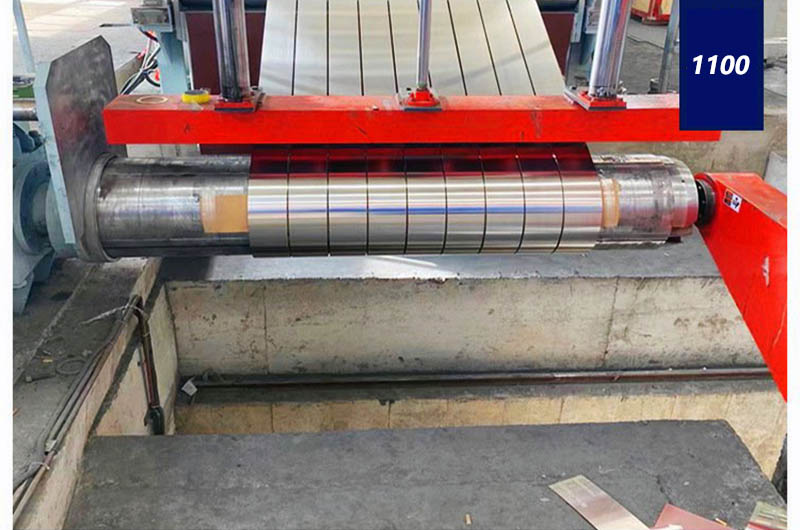
1100 Aluminum Strip Composition
The 1100 aluminum strip is primarily composed of aluminum, with a minimum purity of 99%. It also contains small amounts of other elements such as copper (0.05-0.20%), iron (0.95% max), silicon (0.95% max), and manganese (1.0% max). This composition gives the strip its unique set of characteristics, making it suitable for various industrial applications.
1100 Aluminum Strip Common Temper
Aluminum strips, including those of the 1100 series, are available in different tempers, which affect their mechanical properties.
The common tempers for 1100 aluminum strips include O (annealed), H12, H14, H16, H18, H22, H24, H26, and H32.
1100 Aluminum Strip Typical Temper
- 1100 O Aluminum Strip
- 1100 H12 Aluminum Strip
- 1100 H14 Aluminum Strip
- 1100 H16 Aluminum Strip
- 1100 H18 Aluminum Strip
- 1100 H22 Aluminum Strip
- 1100 H24 Aluminum Strip
- 1100 H26 Aluminum Strip
- 1100 H32 Aluminum Strip
Each temper has specific hardness and formability characteristics, allowing manufacturers to choose the most suitable option for their intended application.
1100 Aluminum Strip Common Specifications
Thickness
1100 aluminum strips are available in a range of thicknesses, typically starting from 0.15mm and going up to 3.0mm.
The choice of thickness depends on the specific requirements of the application, considering factors such as strength, weight, and formability.
Width
The width of 1100 aluminum strips varies widely based on the intended use. Common widths range from 20mm to 1600mm.
Wider strips are often used in applications where large surface areas need to be covered, such as roofing or cladding.
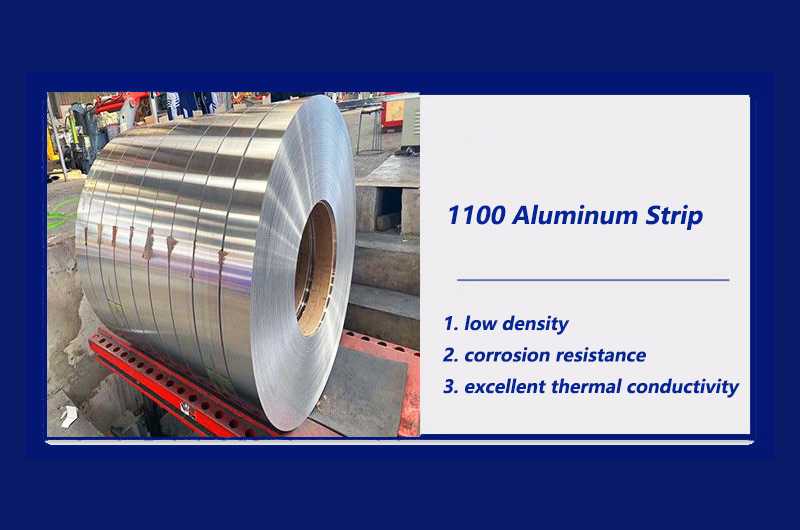
1100 aluminum strip size deviation
1100 aluminum strips have certain dimensional deviation requirements in thickness, width and length, and the general deviation range is between plus and minus a few percentage points.
1100 aluminum strip mechanical properties
1100 aluminum strip has good plasticity and processability, high ductility and hardness, its typical yield strength is 80 MPa, and its tensile strength is 110-150MPa
1100 aluminum strip surface treatment and quality
1100 aluminum strip is a strip material made of pure aluminum. The standard is ASTM B209. This standard specifies the chemical composition, mechanical properties, dimensional deviation, surface quality and other requirements of 1100 aluminum strip.
The surface treatments of 1100 aluminum strips include the following:
- Anodized 1100 aluminum strips
- Brushed 1100 aluminum strip
- 1100 aluminum strips with holes
- 1100 polished aluminum strip
- Powder coated 1100 aluminum strips
-
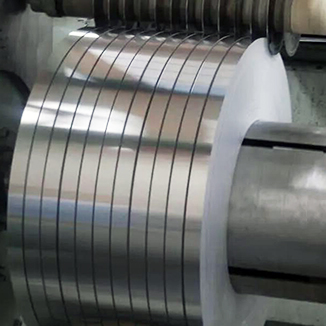
Anodized 1100 aluminum strips
Anodized 1100 aluminum strip refers to 1100 alloy aluminum strip made through an anodizing process. The process involves the formation of a durable oxide layer on the surface through an electrochemical reaction. The result is improved corrosion resistance and an added decorative finish. Anodized aluminum strips can appear in a variety of colors depending on the specific anodizing method used.
-

Brushed 1100 aluminum strip
Brushed 1100 aluminum strip is produced through a mechanical drawing process of 1100 alloy. The method involves using abrasives to create texture on the surface of the aluminum strip. The result is a smooth or matte look that helps hide scratches and provides a decorative finish.
-

1100 aluminum strips with holes
1100 perforated aluminum strip is a 1100 aluminum alloy strip with openings. The perforation process involves punching holes into the strip, and the pattern, size, and spacing of the holes can be customized for the specific application. This type of strip is often used for ventilation, filtration or decorative design purposes.
-
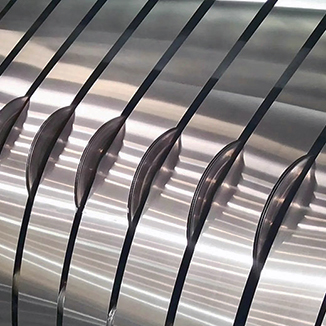
1100 polished aluminum strip
1100 Polished Aluminum Strips undergo a polishing process that involves the use of abrasives and polishing compounds to make the surface smooth and shiny. The result is an aluminum strip with a reflective and glossy appearance, making it suitable for decorative applications that require a smooth and shiny surface.
-
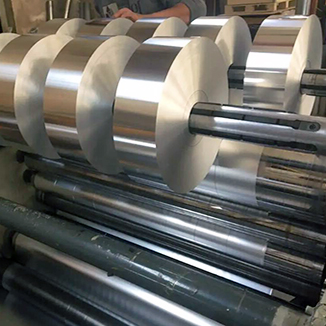
Powder coated 1100 aluminum strips
Powder-coated 1100 aluminum strip is 1100 alloy strip coated with a dry powder coating. The coating process involves electrostatically applying powder coating to an aluminum surface and then curing it under heat. This produces a durable, uniform surface that is available in a variety of colors. Powder coating enhances the corrosion resistance of aluminum strips and provides a consistent appearance.
1100 Aluminum Strip Common Applications
-
1100 Aluminum Strip for Transformer
1100 aluminum strip for transformers refers to a specific type of aluminum strip made of 1100 alloy and designed for use in transformers. Alloy 1100 Aluminum strip is commonly used as winding material in transformer coil construction due to its electrical conductivity, good formability, thermal conductivity.
-
Capacitor casing is made of 1100 aluminum strip
The raw material of the capacitor shell is 1100 alloy aluminum, the homogenizing annealing temperature is 550℃~620℃, the intermediate annealing temperature is 450℃~550℃, and the finished product annealing temperature is 180℃~240℃. The 1100 aluminum strip produced by this method has the characteristics of moderate tensile strength, high elongation, low ear rate, and good overall mechanical properties.
-
1100 Aluminum Strip for Heat Exchangers
The good thermal conductivity of 1100 aluminum makes it suitable for use in heat exchangers. The strips are used in the manufacturing of fins and tubes in heat exchanger systems for applications like air conditioning and refrigeration.
-
Building and Construction
1100 aluminum strips find applications in the construction industry for roofing, cladding, and other architectural elements. Their corrosion resistance and formability make them ideal for outdoor use, where exposure to the elements is a concern.
-
Automotive Industry
In the automotive sector, 1100 aluminum strips are used in various components, including heat shields, decorative trim, and certain body panels. The alloy's lightweight nature contributes to improved fuel efficiency.
-
1100 Aluminum Strip for Packaging
The formability and corrosion resistance of 1100 aluminum strips make them suitable for packaging applications. They are used in the production of foil containers, lids, and other packaging materials.
-
1100 Aluminum Strip for Reflectors and Lighting
The high reflectivity of aluminum, especially in the 1100 alloy, makes it a preferred choice for reflective surfaces. The strips are used in the production of reflectors for lighting fixtures and other applications where reflection is crucial.
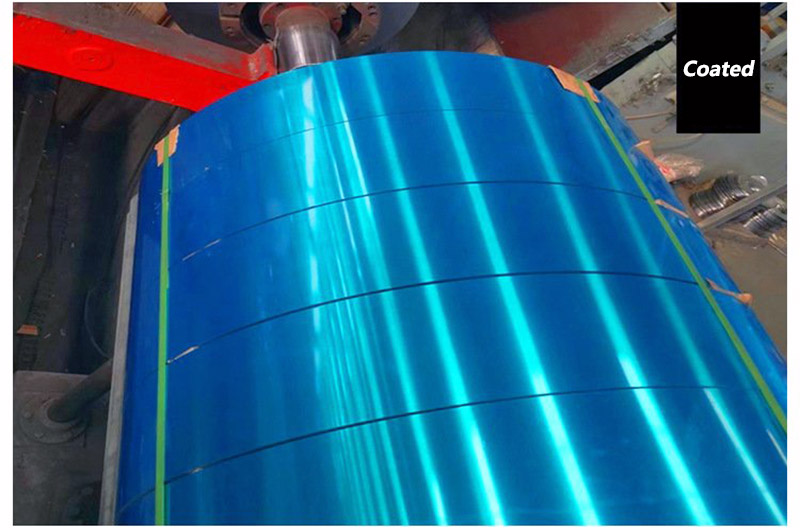
When to Choose 1100 aluminum strip
Choosing the right material for a specific application involves considering various factors such as mechanical properties, corrosion resistance, formability, and cost. The decision to use 1100 aluminum strips, in particular, depends on several key considerations:
1. Corrosion Resistance
If the application requires a material with excellent corrosion resistance, 1100 aluminum is a suitable choice. It is known for its resistance to corrosion in various environments, making it ideal for outdoor applications and those involving exposure to moisture.
2. Formability and Workability
1100 aluminum is highly formable and workable. If your application involves processes like bending, deep drawing, or forming intricate shapes, 1100 aluminum strips are a good option due to their ability to undergo these processes without cracking.
3. Electrical Conductivity
In applications where electrical conductivity is crucial, such as in the production of electrical components like transformers and capacitors, 1100 aluminum is preferred. It has good electrical conductivity properties.
4. Cost Considerations:
For applications where cost is a significant factor and the properties of 1100 aluminum meet the performance requirements, it can be a cost-effective option compared to some other aluminum alloys.
5. Non-Heat-Treatable Requirements:
1100 aluminum is a non-heat-treatable alloy. If your application requires a material that maintains its properties without heat treatment, 1100 aluminum may be suitable.
It's important to note that while 1100 aluminum has several advantageous properties, it may not be the best choice for all applications. Consideration should be given to the specific requirements of the project, including mechanical strength, temperature resistance, and other performance factors, before choosing 1100 aluminum strips.
Additionally, consulting with materials engineers or experts can help in making an informed decision based on the unique demands of the application.
Conclusion
In summary, the 1100 aluminum strip is a versatile material with a wide range of applications. Its composition, combined with various tempers, allows manufacturers to tailor its properties to meet specific requirements.
Whether in electrical components, construction, automotive, or packaging, the 1100 aluminum strip continues to play a vital role in diverse industries, thanks to its excellent combination of formability, conductivity, and corrosion resistance.
Hot Topic about 1100 Aluminum Strip
- What is the difference between 1100 and 6061?
- What is 1100 Aluminium alloy used for?
- What is aluminum plate grade 1100?
- Does 1100 aluminum work harden?
Haomei Aluminum is a manufacturer specializing in the production, wholesale and customization of aluminum plates and strips. As a 1100 aluminum strip supplier, we not only have complete specifications of 1100 aluminum strip, but also strictly implement the standards for 1100 aluminum strip performance and 1100 aluminum strip standard. And provide our customers with competitive quotations.
